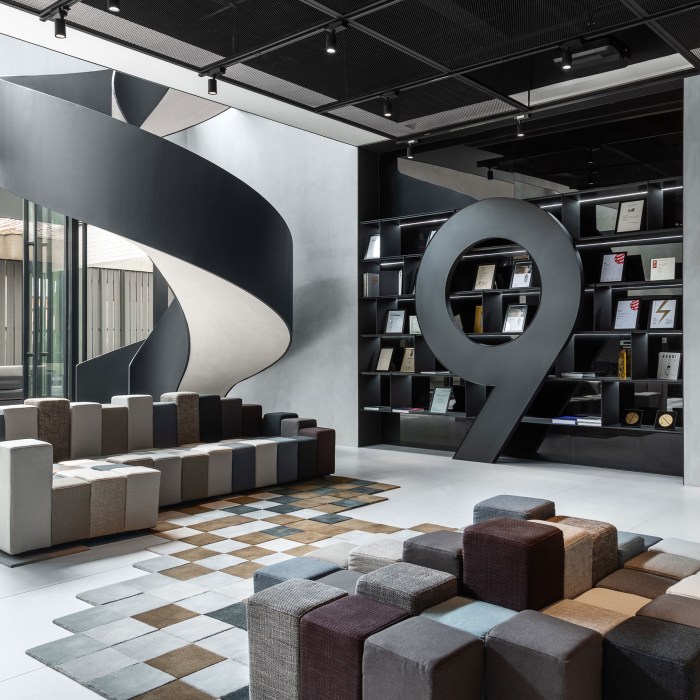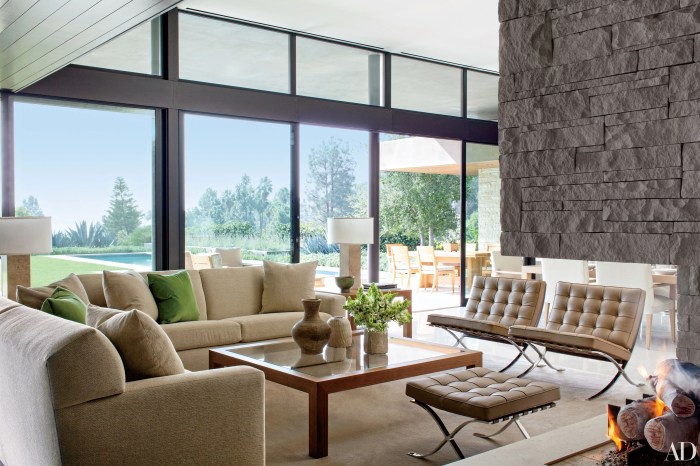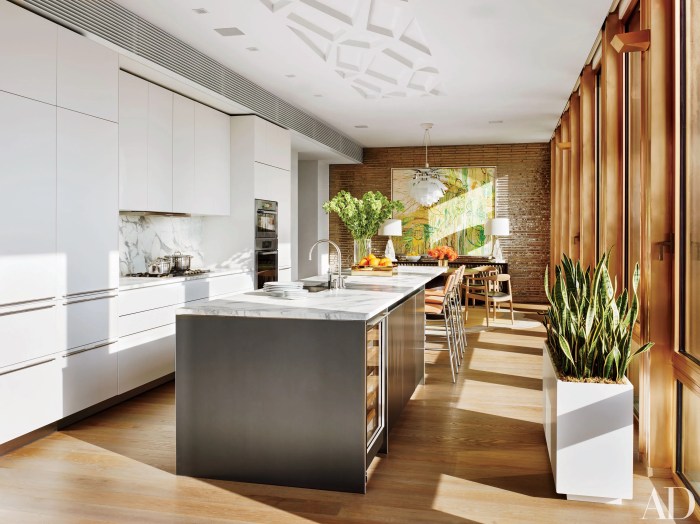Exploring the World of Architecture and Interior Design

Diving into the realm of architecture and interior design, this introduction sets the stage for a captivating journey through the intricacies of shaping living spaces. From the impact on our daily lives to creating functional and aesthetically pleasing environments, the fusion of architecture and interior design is a fascinating exploration of creativity and functionality.
As we delve deeper, we uncover the essential elements of architectural design, the principles of interior design, influential architectural styles, current design trends, and the intricate process behind bringing these visions to life.
Importance of Architecture and Interior Design
Architecture and interior design play a crucial role in shaping the spaces we inhabit, influencing our daily lives in numerous ways. From functionality to aesthetics, these disciplines have a significant impact on our environment and well-being.
Shaping Living Spaces
Architecture and interior design are essential in creating spaces that are not only visually appealing but also functional and efficient. The layout, materials, and overall design of a building or room can greatly affect how we interact with our surroundings.
Impact on Daily Lives
- Architectural design determines the flow and organization of spaces, affecting how we move and engage with our environment on a daily basis.
- Interior design choices, such as color schemes and furniture placement, can influence our mood, productivity, and overall well-being.
- Both architecture and interior design contribute to creating spaces that cater to our needs and enhance our quality of life.
Creating Functional and Aesthetically Pleasing Spaces
By combining functionality with aesthetics, architecture and interior design work together to create spaces that are not only practical but also visually appealing. These disciplines strive to strike a balance between form and function, ensuring that the spaces we inhabit are both beautiful and usable.
Elements of Architecture

Architecture is a complex art form that involves various elements working together to create functional and aesthetically pleasing structures. Key elements in architectural design include form, function, materials, and structure. Each of these elements plays a crucial role in shaping the overall design of a building.
Form
Form in architecture refers to the shape and structure of a building. It encompasses the overall appearance and style of a structure, including its size, scale, and proportions. The form of a building not only affects its aesthetics but also influences how people interact with the space.
Function
Function is another essential element in architectural design, focusing on the purpose and use of a building. Architects must consider the practical needs of the users when designing a space, ensuring that it is functional, efficient, and meets the requirements of its intended use.
Materials
Materials play a vital role in architecture, determining the durability, sustainability, and aesthetic appeal of a building. The choice of materials can affect the overall look and feel of a structure, as well as its environmental impact. Architects must carefully select materials that are both functional and visually appealing.
Structure
Structure refers to the framework that supports a building, ensuring its stability and integrity. The structural design of a building is essential for its safety and longevity, as well as its overall aesthetic appeal. Architects must consider the structural requirements of a building when creating their designs.
Importance of Lighting, Color, Texture, and Space
In addition to the key elements of architecture, factors such as lighting, color, texture, and space play a significant role in architectural design. These elements can greatly impact the look and feel of a building, creating atmosphere and enhancing the user experience.
Lighting
Lighting is a crucial element in architecture, as it can affect the mood, functionality, and aesthetics of a space. Natural light, artificial light, and their distribution throughout a building can greatly influence the way people perceive and interact with the environment.
Color
Color has the power to evoke emotions, create visual interest, and define the character of a space. Architects use color to enhance architectural features, highlight focal points, and establish a cohesive design scheme. The choice of colors can greatly impact the overall ambiance of a building.
Texture
Texture adds depth, richness, and tactile appeal to architectural design. Different textures can create contrast, visual interest, and a sense of warmth in a space. Architects often use a combination of textures to add complexity and character to their designs.
Space
Space is a fundamental element in architecture, defining the volume, circulation, and functionality of a building. Architects carefully consider spatial relationships, proportions, and flow to create environments that are both comfortable and inspiring. The manipulation of space can greatly influence the way people experience and interact with a space.
Relationship Between Architecture and Environmental Sustainability

Architecture has a significant impact on the environment, making sustainability a crucial consideration in modern design. By incorporating eco-friendly practices and technologies, architects can create buildings that are energy-efficient, environmentally responsible, and beneficial to the planet.
Interior Design Principles
Interior design principles play a crucial role in creating aesthetically pleasing and functional spaces. These principles guide designers in achieving a harmonious balance in interior spaces, ensuring that every element works together seamlessly.
Balance
Balance in interior design refers to the equal distribution of visual weight in a space. There are three types of balance: symmetrical, asymmetrical, and radial. Symmetrical balance involves mirroring elements on either side of a central axis, creating a sense of formality and stability.
Asymmetrical balance, on the other hand, involves arranging different elements to achieve equilibrium without mirroring each other. Radial balance revolves around a central point, with elements radiating outward in a circular or spiral pattern.
Harmony
Harmony in interior design is the coherence and unity of all elements in a space. It involves creating a cohesive look by ensuring that colors, textures, patterns, and materials complement each other. Achieving harmony helps create a sense of visual comfort and completeness in a room.
Rhythm
Rhythm in interior design refers to the repetition of elements to create a sense of movement and visual interest. There are three types of rhythm: regular, alternating, and progressive. Regular rhythm involves the repeated use of the same element in a consistent pattern.
Alternating rhythm alternates between two or more elements to create visual variety. Progressive rhythm involves a sequence of elements that gradually increase or decrease in size, color, or texture.
Emphasis
Emphasis in interior design is about creating a focal point or a visual center of interest in a space. By highlighting certain elements through color, texture, shape, or placement, designers can draw attention to specific areas and create visual impact.
Emphasis helps guide the viewer's eye and adds depth and dimension to a room.
Scale and Proportion
Scale and proportion play a vital role in interior design, ensuring that all elements in a space relate harmoniously to each other. Scale refers to the size of an object in relation to the space it occupies, while proportion involves the relationship between different elements in terms of size, shape, and visual weight
By carefully considering scale and proportion, designers can create a sense of balance and harmony in a room.
Furniture Layout and Accessories
The layout of furniture and the selection of accessories can significantly impact the look and feel of an interior space. Proper furniture arrangement can enhance functionality and flow, while accessories like lighting, artwork, and textiles can add personality and style to a room.
By strategically placing furniture and accessories, designers can create a cohesive and inviting environment that reflects the client's taste and lifestyle.
Influential Architectural Styles
When it comes to architecture, different styles have emerged over time, each with its own unique characteristics and elements. These architectural styles play a significant role in shaping the design of buildings and influencing interior design trends.
Modern Architecture
Modern architecture emerged in the early 20th century and is characterized by simplicity, clean lines, and the use of modern materials such as glass and steel. Buildings in this style often prioritize functionality and minimal ornamentation.
Contemporary Architecture
Contemporary architecture refers to the architecture of the present day and is constantly evolving. It often combines elements from various styles and focuses on sustainability, innovation, and experimentation. Flexibility and open floor plans are common features of contemporary buildings.
Minimalist Architecture
Minimalist architecture is all about simplicity and the idea that less is more. Clean lines, simple forms, and a focus on functionality are key elements of this style. Minimalist buildings often have a sense of openness and a lack of clutter.
Traditional Architecture
Traditional architecture draws inspiration from historical styles and regional influences. It often features ornate details, intricate craftsmanship, and a sense of symmetry. Traditional buildings reflect the cultural heritage and history of a particular region.
Evolution of Architectural Styles
Architectural styles have evolved over time in response to changing societal needs, technological advancements, and cultural influences. As architecture progresses, it continues to push boundaries and explore new possibilities, impacting interior design trends along the way.
Interior Design Trends
Keeping up with the latest interior design trends is crucial for creating modern and stylish spaces. From colors to materials and furniture choices, trends are constantly evolving to reflect the current preferences and lifestyles of people.
Colors
Color trends in interior design often mirror larger societal shifts. Currently, earthy tones like terracotta, olive green, and warm neutrals are popular choices for creating cozy and inviting spaces. Bold and moody colors such as navy blue and forest green are also making a statement in modern interiors.
Materials
Natural materials like wood, stone, and metal are dominating interior design trends, emphasizing sustainability and connection to nature. Textured materials such as rattan, jute, and linen add depth and warmth to spaces, creating a harmonious environment.
Furniture
Minimalism and functionality are key aspects of contemporary furniture design trends. Clean lines, geometric shapes, and multifunctional pieces are favored to maximize space and create a streamlined look. Vintage and retro furniture styles are also experiencing a resurgence, adding a touch of nostalgia to modern interiors.
Technology and Sustainability
Advancements in technology have revolutionized interior design, allowing for smart home integration, energy-efficient solutions, and innovative materials. Sustainability is a major driving force behind modern interior design trends, with a focus on eco-friendly practices, recycled materials, and energy-saving design elements.
Cultural Influences
Cultural influences play a significant role in shaping interior design trends, with global events and societal changes impacting design choices. From multicultural design elements to traditional craftsmanship techniques, cultural diversity adds richness and depth to modern interiors, creating unique and personalized spaces.
Architectural and Interior Design Process

Architecture and interior design projects involve a series of steps that are essential for the successful completion of a design. Throughout the process, architects, interior designers, and clients work together to bring the vision to life.
Concept Development
Concept development is a crucial step in the architectural and interior design process. During this phase, designers brainstorm ideas, explore different design possibilities, and create a concept that aligns with the client's needs and preferences. This stage sets the foundation for the entire project and helps in creating a cohesive design vision.
Space Planning
Space planning is another important aspect of the design process. It involves determining how the available space will be utilized effectively to meet the functional and aesthetic requirements of the project. Architects and interior designers carefully plan the layout of rooms, furniture placement, circulation paths, and other spatial elements to optimize the use of space.
3D Visualization
D visualization plays a key role in helping clients and designers visualize the final design concept. By creating detailed 3D models and renderings, architects and interior designers can present a realistic representation of the proposed design. This allows clients to better understand the design concept and make informed decisions before the construction phase begins.
Collaboration
Collaboration is essential throughout the architectural and interior design process. Architects, interior designers, and clients work closely together to ensure that the design meets the client's expectations and requirements. Effective communication, feedback, and collaboration help in refining the design, addressing any concerns, and ultimately delivering a successful project.
Last Recap
In conclusion, the dynamic interplay between architecture and interior design unveils a world where creativity meets practicality, where trends evolve with cultural influences, and where spaces are transformed into reflections of individuality and style. Delve further into this captivating world to discover the endless possibilities of architectural and interior design.
Helpful Answers
What is the role of architecture and interior design in shaping living spaces?
Architecture and interior design play a crucial role in creating functional, aesthetically pleasing environments that reflect the needs and preferences of individuals inhabiting those spaces.
How do architectural styles influence interior design trends?
Architectural styles serve as a foundation for interior design trends, with elements and characteristics from various styles influencing the way spaces are designed and decorated in modern times.
What are the key elements in architectural design?
Key elements in architectural design include form, function, materials, structure, lighting, color, texture, and space, all of which contribute to the overall look and feel of a building or space.
How do interior design principles impact the layout of a space?
Interior design principles like balance, harmony, rhythm, and emphasis guide the layout of a space, ensuring that elements work together cohesively to create a visually appealing and functional environment.
What is the significance of concept development in the architectural and interior design process?
Concept development is crucial in establishing the foundation of a design project, setting the tone for the overall aesthetic and functionality of the space being created.

